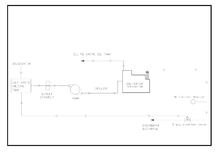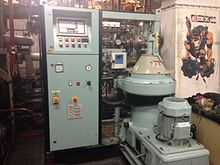Oily water separator
An oil water separator (OWS) is equipment to separate oil and water mixtures into their separate components. They are most commonly found on board ships where they are used to separate oil from oily waste water such as bilge water before the waste water is discharged into the environment.
Research has demonstrated laboratory and pilot scale systems that also incorporate capabilities to remove heavy metals, cleaners, glycol, solvents, phosphates and nitrates.[1]
Bilge Water is an unavoidable product of ship board operations. Oil leaks from running machinery such as diesel generators, air compressors, and the main propulsion engine. Modern OWSs have alarms and automatic closure devices which are activated when the oil storage capacity of the oil water separator has been reached.

Purpose
The purpose of shipboard Oily Water Separator (OWS) is to separate oil and other contaminants that could be harmful for the oceans. The International Maritime Organization (IMO) publishes regulations through the Marine Environment Protection Committee (MEPC).[2] On January 1, 2005 the MEPC issued new regulations that each vessel built after this date had to follow. Each OWS must be able to achieve clean bilge water under 15 ppm of type C oil or heavily emulsified oil, and any other contaminates that may be found. All Oil Content Monitors (OCM) must not be able to be tampered with. Also whenever the OWS is being cleaned out the OCM must be active for zeroing it out. An OWS must be able to clear out contaminants as well as oil. Some of these contaminating agents include lubricating oil, cleaning product, soot from combustion, fuel oil, rust, sewage, and several other things that can be harmful to the ocean environment.[3]
Bilge
The Oily Water Separator (OWS) is the main transportation of the bilge. The bilge area is the lowest area on a ship. This is where most of the liquid drains from things such as steam boilers, water purification systems and oil lab deep sink drains. The main places in this hull of the ship, where Bilge drains to is the main engine room, auxiliary Machine rooms and shaft ally. This is where the water is collected and referred to as "bilgewater" or "oily waste water". The bilgewater that collects here include drain/leftover water from the boilers, water collecting tanks, drinking water and other places where water can be overflowed. However, bilgewater doesn’t just include water drains. Another system that drains into the Bilge system comes from the propulsion area of the ship. Here fuels, lubricants, hydraulic fluid, antifreeze, solvents, cleaning chemicals also drain into the bilge system in small quantities. The OWS is intended to remove a large proportion of these contaminants before discharge to the environment
Regulations for treated water discharge
USA
History
In 1948 a Water Pollution Control Act (WPA) was passed by the federal government.[4] This act gave rights to the surgeon general of the public health service to make programs to decrease the amount of pollution in the world’s waters. The main concern was to save water, protect fish, and have clean water for agricultural usage. The WPA also helped to start the process of building water treatment plants. This is to guard against sewage from polluting drinking water. In 1972 the WPA was amended to include more requirements in order to insure that the water is chemically sound. This amendment also furthered regulations to insure the quality of the water was up to par.[5] In 1987 the WPA was amended again to put an even more strict control on water supply pollution. With this new amendment water sources had to fit a specific set of criteria to fight against pollution. The WPA was amended looking and evaluating what goes into the waters, and determines whether they will lower the quality of water or not.[6]
Current USA regulations
The regulations in the Clean Water Act limits what may be discharged to sea from an OWS in USA waters. Current limits are < 15 mg/l oil for discharges within 12 nautical miles of shore or 100 mg/l outside that limit.[7] In order to get rid of the additives in the bilgewater, things like oil, and other fluids, regulations have been made to treat this water. In order to treat this water, it needs to be circulated in an Oily Water Separator so that it can be transferred over board. The OWS system also can be used to retrieve the leftover oil that was extracted from the Oily water. The left over oil has two options, it could be put in a holding tank and discharged at a later time to a waste oil treatment company, or it could be cycled though waste oil cyclers and treated.[8] Typical OWS systems must he contained in an Oily Waste Holding Tank (OWHT). From the OWHT the bilge water then travels, using gravity phased separation, coalescence beds, or centrifugal separation to proceed with the separation of the oil or other containments from the Bilgewater.
Europe and Canada
European countries and Canada have stricter rules on discharge and discharges must contain less than 5 mg/l of contaminants.[9]
The discharge of oil contaminated waters are also subject to international controls such as the International Convention for the Prevention of Pollution from Ships (MARPOL), and International Maritime Organization (IMO). These organizations set strict limits to protect marine life and coastal environments. These agency require logs to be kept of any discharges of contaminated water.[10]
Types Of Oily Water Separators

Gravity plate separator
A gravity plate separator contains a series of oleophilic plates through which the contaminated water flows. The oil in the water coalesces on the underside of the plate eventually forming droplets before coalescing into liquid oil which floats off the plates and accumulates at the top of the chamber. The oil accumulating at the top is then transferred to waste oil tank on the vessel where it is later discharged to a treatment facility shoreside. This type of Oily Water Separator is very common in ships but it has some flaws that decrease efficiency. Oil particles that are twenty micrometers or smaller do not get separated. The variety of oily wastes in bilge water can limit removal efficiency especially when very dense and highly viscous oils such as bunker oil are present. Plates must be replaced when fouled, which increases the costs of operation.[1]
Electrochemical
Wastewater purification of oils and contaminates by electrochemical emulsification is actively in research and development. Electrochemical emulsification involves the generation of electrolytic bubbles that attract pollutants such as sludge and carry them to the top of the treatment chamber. Once at the top of the treatment chamber the oil and other pollutants are transferred to a waste oil tank.[11]
Bioremediation
Bioremediation is the use of microorganisms to treat contaminated water. A carefully managed environment is needed for the microorganisms which includes nutrients and hydrocarbons such as oil or other contaminates, and oxygen.
In pilot scale studies, bio-remediation was used as one stage in a multi-stage purification process involving a plate separator to remove the majority of the contaminants and was able to treat pollutants at very low concentrations including organic contaminates such as glycerol, solvents, jet fuel, detergents, and phosphates. After treatment of contaminated water, carbon dioxide, water and an organic sludge were the only residual products.[1]
References
- ↑ 1.0 1.1 1.2 Caplan, J. A., Newton, C., & Kelemen, D. (2000). Technical report: Novel oil/water separator for treatment of oily bilge water. Marine Technology and SNAME News, 37(2), 111.
- ↑ International Maritime Organization. (May 21, 2013). IMO Marine Environment Protection Committee 65th session pushes forward with energy-efficiency implementation. Retrieved from http://www.imo.org/MediaCentre/PressBriefings/Pages/18-MEPC65ENDS.aspx#.U0gcHPldU4c
- ↑ Van Hemmen H. F. (unknown). Initial Recommendations for Bilge Oily Water Separator System Design and Operation. Retrieved from http://legacy.sname.org/committees/tech_ops/oilywater/meets06.pdf
- ↑ Environmental Protection Agency. (December 17, 2012). Clean Water Act. Retrieved from http://cfpub.epa.gov/npdes/cwa.cfm?program_id=45
- ↑ U.S. Fish & Wildlife Service. (2013). Federal Water Pollution Control Act (Clean Water Act). Retrieved from http://www.fws.gov/laws/lawsdigest/FWATRPO.HTML
- ↑ United States Environmental Protection Agency. (2012). Water Quality Standards History. Retrieved from http://water.epa.gov/scitech/swguidance/standards/history.cfm
- ↑ EPA. Phase one final rule and technical development document of uniform national discharge standards: surface vessel bilgewater/ oil water separator: nature of discharge. Retrieved from http://water.epa.gov/lawsregs/lawsguidance/cwa/vessel/unds/upload/2007_07_10_oceans_regulatory_unds_TDDdocuments_appAsurface.pdf
- ↑ United States Environmental Protection Agency. (2013). Oil Water Separators. Retrieved From http://www.epa.gov/oem/docs/oil/spcc/guidance/5_OWSeparators.pdf
- ↑ Ghidossi, R., Veyret, D., Scotto, J., Jalabert, T., & Moulin, P. (2009). Ferry oily wastewater treatment. Separation and Purification Technology, 64(3), 296-303.
- ↑ GARD AS. (December, 2013). Prevention of pollution of oil. Retrieved from http://www.gard.no/ikbViewer/Content/72338/pollution
- ↑ Yang, C. (2007). Electrochemical coagulation for oily water demulsification. Separation and Purification Technology, 54(3), 388-395.